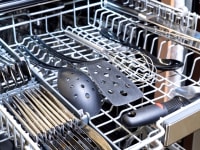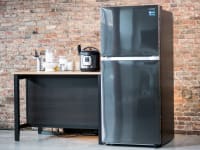Keurig vs. Nespresso: Battle of the single-serve coffee makers
Which pod coffee maker is right for you?
 Credit:
Reviewed / Timothy Renzi
Credit:
Reviewed / Timothy Renzi
Recommendations are independently chosen by Reviewed's editors. Purchases made through the links below may earn us and our publishing partners a commission. Prices were accurate at the time this article was published but may change over time.
Keurig, the single-serve coffee brand, has dominated the Canadian coffee machine market since it took off in the early 2000s. With new competitors emerging, Keurig has been upping its game by adding more flavours, functionality, and smart-home programs to its convenient units. In response, competitors have brought in their own innovations. Nestle’s Nespresso Vertuo machines brings a layer of depth and sophistication to the pod approach, resulting in aroma-rich, luxurious, and more expensive coffee.
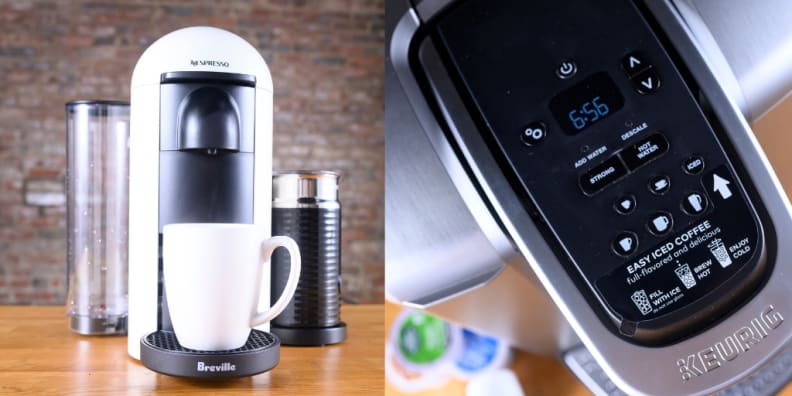
Nespresso (left) and Keurig (right) have different systems to control brewing size.
After testing the best pod coffee makers in our U.S. labs, we decided that the Nespresso VertuoPlus by Breville is the best investment for most pod-coffee fans, while the Keurig K-Cafe is an excellent option if versatility is your priority.
But what really sets the two brands apart? And which is right for your daily double-double? Read on to see how these titans of the single-serve coffee maker market compare.
The cost
If you opt for in-home brewing over a daily trip to your nearest coffee shop, you probably take pricing pretty seriously. Most of the non-commercial Keurig machines retail from $80 to $249 with a range of selections that cater to different needs.

Nespresso capsules cost more than K-Cups, but it's still cheaper than going to a coffee shop.
The Nespresso machines used to come with a much higher price tag, but the newer VertuoLine has become more affordable. You can buy a Nespresso Vertuo coffee maker for as cheap as $175. This is undoubtedly part of Nestle’s strategy to acquire more of the market share from its pod coffee competitors. But it's not a discount line by any means—the higher-end models and bundle deals that come with a milk frother (an addition that one of our editors adores) can cost over $300.
After purchasing the machine, you have to factor in the cost of the coffee pods. The Keurig K-Cup pods are less expensive, averaging from as low as 70¢ to as high as 90¢ per serving. Due to its larger pod sizes, the Nespresso VertuoLine now costs 88¢ to $1.12 per serving. With Keurig, you’ll have the option of a reusable filter, which allows you to brew with your own ground coffee.
Ultimately, using K-Cups is going to be the most effective way to cut spending. A one-coffee-per-day user would spend around $2-$4 on coffee at the shop, and that's at least $60 per month. The most expensive Keurig is $249, and the pods would cost about $21 per month. So even if you're forking over $270 for the first month, your coffee budget goes down to $21 per month after that. Using a Nespresso machine and capsules, in comparison, will cost you $300 upfront for the most expensive machine, and $26 per month for capsules in the months following.
The variety of brews
Keurig’s K-Cup pods offer more than 400 beverage varieties from 60 brands, including several best-selling coffee brands. These beverages include coffee, hot chocolate, tea, lemonade, and fruity drinks. And all the Keurig-owned and third-party K-Cup pods are compatible with the K-series brewing systems. You can even fill the coffee of your choice into a reusable K-Cup filter to cater to any highly specific needs.
The Nespresso VertuoLine, which features a bar-code scanning technology, has fewer options. This lack of variety might be a disadvantage for some, but coffee aficionados may be able to overlook the limited selection due to the high quality of the coffee that is available.
Recycling
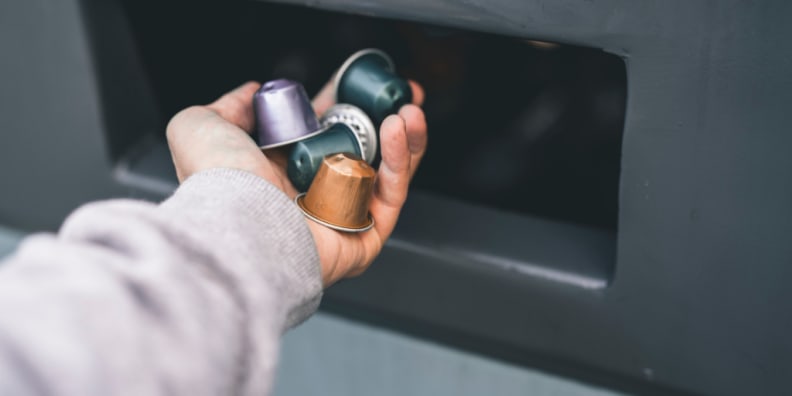
Efficiently recycling your used pods can decrease their environmental impact.
Over the last few years, Keurig has been making an effort to produce recyclable coffee pods. As the website claims, all pods made in Canada are 100 percent recyclable.
To recycle K-Cups, you simply need to peel the lid open, then empty or dispose of the grounds. Rinse the pods underwater and throw them into a recycling bin.
The Nespresso capsules are advertised as easily recyclable, but you can't always toss them in your bin and call it a day. The company encourages customers to use its own recycling channels because not all municipalities recycle the type of aluminum that the pods are made from—and because dumping out the coffee grounds can be kind of a pain.
The company offers a few options for customers in provinces that do not accept pods for recycling. Nespresso offers free pod-recycling bags with prepaid Canada Post shipping labels. Those bags can be mailed back to Nespresso from any Canada Post mailbox. If you prefer, you can also bring used pods to a boutique retailer or a collection site and the company will do the rest. You can find how to recycle pods in your province here.
Nespresso’s centralized recycling system guarantees all capsules are properly recycled. Although you can manually recycle some K-Cups, contamination in the single-stream recycling process seems to be inevitable, so it’ll be difficult to make sure your clean pods aren’t wasted. For now, Nespresso wins the environmentally-friendly badge.
Brewing method
Like traditional drip machines, Keurigs adopt a simple approach: pressure brewing. The machine punches two holes in the center and the bottom of the K-Cups, and coffee gets squeezed out by pressure. It takes about 45 seconds to one minute of brewing time to produce an eight-ounce (236 ml) or ten-ounce (296 ml) cup of coffee.

K-Cups (left) and Nespresso pods (right) are punctured differently by their respective machines, which affects the taste and quality of the brewed coffee.
While the traditional pod machine uses this rudimentary pressure method of coffee brewing, the Nespresso machines have adopted centrifusion to increase the contact of coffee beans and hot water, which leaves a layer of foamy crema on top of each cup.
The Nespresso VertuoLine—not to be confused with Nespresso Pixie, the espresso maker—uses this advanced centrifusion technology. It combines centrifugal action and water fusion to spin the capsule at around 7,000 rpm. The machine penetrates each capsule in the center and around the edges, after which the water is injected in the middle and pressed out from the 20 openings on the edges.
When it comes to brewing method, time and temperature are the main factors that can determine the quality of the coffee. Nespresso uses barcode scanning technology so the machine can read what temperature and time combination should be used upon brewing. The result? The Nespresso machines simply brew much better coffee than most Keurigs. The thin layer of crema produced by Nespresso's centrifugal approach further enhances the aroma and taste experience.
Design, storage, and ease of use
When Nestle unveiled its first-generation single-serve espresso maker, the Pixie, people raved about its sleek and luxurious design. The second-generation model for coffee, the VertuoLine, continues this legacy with its stylish appearance and range of colour options to suit almost every kitchen.
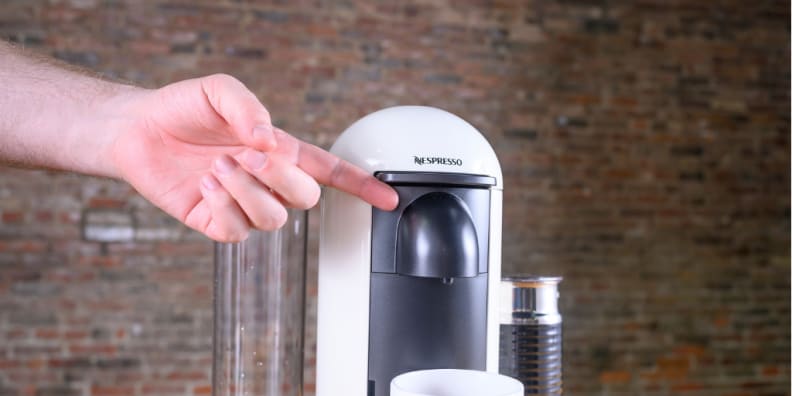
Nespresso VertuoPlus by Breville features intuitive design.
Keurig models are larger and take up more countertop space—in part due to their much larger reservoirs. When it comes to brewing large cups of coffee, the Keurig K-Elite is able to handle more than eight cups of eight-ounce coffee. In comparison, the Nespresso only brews six cups of the same-sized coffees.
Both companies have incorporated intuitive design into the machines’ control panels, so they’re equally easy to use. A small difference is that Nespresso VertuoLine ejects used capsules automatically into a container, so you won’t have to replace the hot pods by hand.
Another detail to note is that all single-serve coffee makers need routine cleaning and descaling once every six months. To descale the machines, you can simply add descaling solution to the water tank and press a button.
The final verdict
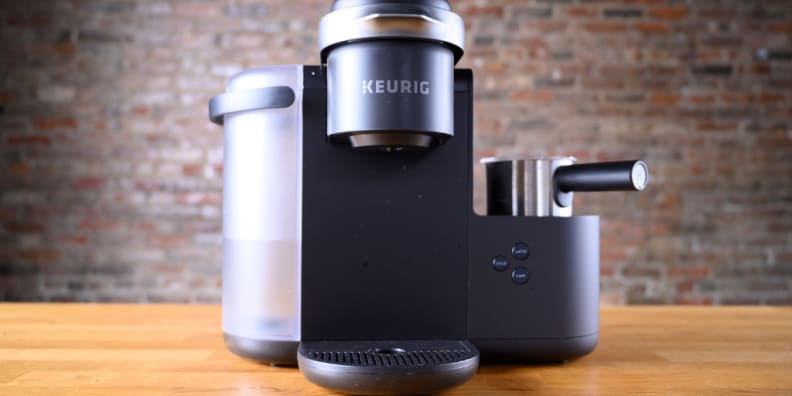
The K-Cafe brews coffee, lattes, and cappuccinos.
Though Keurig's single-serve coffee makers offer a huge variety of beverages to choose from, Nespresso's machines make coffee that simply tastes better, brewing a rich, aroma-filled cup every time. And it's not just me subjectively deciding that the Nespresso coffee is better—brewing technology dictates that a Nespresso produces more full-bodied coffee than a Keurig.
Since I live in a household without split opinions on dark and blonde roast, I would lean toward investing in a Nespresso VertuoPlus by Breville for its consistent performance and ability to produce luxurious crema.
For people in big households or for office use, a Keurig might be better at fulfilling everyone’s coffee demands. In those instances, I’d recommend this Keurig K-Cafe—the most versatile machine in our single-serve pod brewer roundup.

